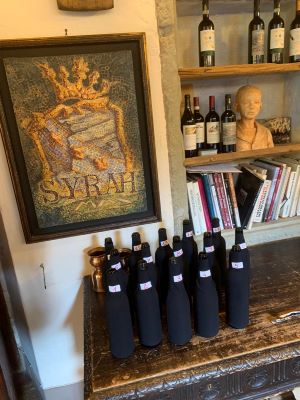For the past few years we have been bringing together in a single tasting session the wines of the three appellations featured in the 1716 proclamation of the Grand Duke of Tuscany Cosimo III de’ Medici: Rufina (where we went this year), Valdarno and Carmignano.
Tasting period for the new Essential Guide. A fun time but also challenging because of the rather tight schedule. In recent years three consortia have been facilitating our work by putting their wines together in a common venue that is itinerant. Under the supervision of engineer Paolo Valdastri, the Chianti Rufina, Carmignano and Valdarno di Sopra consortia allow us to optimize our time with a single trip.



Rufina
This year we were guests of Rufina (I think the name Chianti for this appellation is of no benefit), which was presenting wines from the ambitious Terraelectae project. A project involving 100% Sangiovese from a single estate vineyard. There were 13 samples present, many of which were already well-known wines bearing the new “name.” In fact, it is not a true typology, as Terraelectae was born from a free association between producers since it would be impossible to modify only for Rufina the Chianti specification. Okay it is not news, practically the same concept as the Alliance born years ago in Montepulciano, however to the Rufinesi it seems like a “Copernican revolution.”

The 13 samples covered the 2018-19-20 vintages, perhaps a joint release would have been desirable to give a message of breakthrough and greater unity. The good news that some of these are very good, others denote a corporate path toward quality that cheers us up. Unfortunately, some samples have not overcome what is the Rufina “problem,” which is a technical problem due to often obsolete woods that olfactively disfigure the quality of the grapes and the potential of the terroir. Outdoor fermentation vats without temperature controls certainly do not help. This emerges when tasting the “aged” wines while the all-steel or basic Rufina wines are very pleasant and charming. But let us not despair because there are excellent products: Frascole Villa alla Stele, Frescobaldi Montesodi, I Veroni Quona, Il Pozzo Vigna il Fiorino.
Carmignano
 Carmignano continues a nice growth that invests across the denomination and that is good. Every year we have some important new entries (last year Pratesi, this year Ceri) a sign of a beautiful vitality. The historic wineries continue without relenting and chart the course with style and confidence giving stylistic reference points that are fundamental for newcomers or those who are growing. Capezzana, Piaggia, Fattoria Ambra always work very well and also the growth of the historic Tenuta di Artimino will close a virtuous circle. The 2020 vintage of Carmignanos, rather complex and hot, has made some fall into temptation to over-ripen the grapes with wines that are ripe on the nose and not very agile on the palate especially in the Medici component (the Cabernet that has always completed the blend with Sangiovese). While the best have also handled this difficulty well. The reserves and selections are more homogeneous in quality, a sign of a clear vision in both harvest and aging choices.
Carmignano continues a nice growth that invests across the denomination and that is good. Every year we have some important new entries (last year Pratesi, this year Ceri) a sign of a beautiful vitality. The historic wineries continue without relenting and chart the course with style and confidence giving stylistic reference points that are fundamental for newcomers or those who are growing. Capezzana, Piaggia, Fattoria Ambra always work very well and also the growth of the historic Tenuta di Artimino will close a virtuous circle. The 2020 vintage of Carmignanos, rather complex and hot, has made some fall into temptation to over-ripen the grapes with wines that are ripe on the nose and not very agile on the palate especially in the Medici component (the Cabernet that has always completed the blend with Sangiovese). While the best have also handled this difficulty well. The reserves and selections are more homogeneous in quality, a sign of a clear vision in both harvest and aging choices.
Valdarno di Sopra
 Valdarno di Sopra also did very well, which, in the face of few wineries, centers excellent team results and with a multiplicity of grape varieties, a sign of a widespread vocation of the area that could be “broken down” according to the best performing grape varieties. In percentage terms, the most widespread grape variety is Sangiovese, which remains the one that suffers the most in the average scores. Also in this area we have four super-established realities: Petrolo, Il Carnasciale, Tenuta Setteponti and Il Borro, which with the acquisition of Ferragamo has greatly improved in quality. Four reference wines like Galatrona, Caberlot, Borro and Oreno generating almost a continental and fresh Bolgheri. Then several estates with goodies like La Salceta’s rosé and various Sangiovese. In short, reliable and fascinating area, even on some whites.
Valdarno di Sopra also did very well, which, in the face of few wineries, centers excellent team results and with a multiplicity of grape varieties, a sign of a widespread vocation of the area that could be “broken down” according to the best performing grape varieties. In percentage terms, the most widespread grape variety is Sangiovese, which remains the one that suffers the most in the average scores. Also in this area we have four super-established realities: Petrolo, Il Carnasciale, Tenuta Setteponti and Il Borro, which with the acquisition of Ferragamo has greatly improved in quality. Four reference wines like Galatrona, Caberlot, Borro and Oreno generating almost a continental and fresh Bolgheri. Then several estates with goodies like La Salceta’s rosé and various Sangiovese. In short, reliable and fascinating area, even on some whites.



